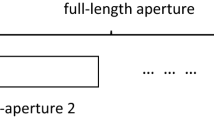Abstract
In this paper, we develop an integrative synchronization and imaging algorithm for bistatic synthetic aperture radar (BSAR) using Global Navigation Satellite Systems as transmitters and a fixed receiver. Due to the lack of a dedicated synchronization link, the usage of navigation signals and the system complexity, traditional synchronization and imaging solutions are not applicable for GNSS-based BSAR. To resolve this problem, this paper focuses on the integrative signal processing algorithm for GNSS-based BSAR. Firstly, to remove the effect of navigation signals, synchronization pre-processing is developed. Then the principle of measuring errors neutralization is theoretically proved by considering the geometric peculiarity of the system. Based on this principle, an integrative synchronization and imaging algorithm is proposed. Finally, the validity of the developed algorithm is confirmed by experimentally obtained data.
Similar content being viewed by others
References
Rodriguez-Cassola M, Baumgartner S V, Krieger G, et al. Bistatic TerraSAR-X/F-SAR spaceborne-airborne SAR experiment: description, data processing, and results. IEEE Trans Geosci Remote Sens, 2010, 48: 781–794
Walterscheid I, Espeter T, Brenner A R, et al. Bistatic SAR experiments with PAMIR and TerraSAR-X: setup, processing and image results. IEEE Trans Geosci Remote Sens, 2010, 48: 3268–3279
Sanz-Marcos J, Lopez-Dekker P, Mallorqui J J, et al. SABRINA: a SAR bistatic receiver for interferometric applications. IEEE Geosci Remote Sens Lett, 2007, 4: 307–311
Behner F, Reuter S. HITCHHIKER, Hybrid bistatic high resolution SAR experiment using a stationary receiver and TerraSAR-X. In: Proceedings of European Conference on Synthetic Aperture Radar (EUSAR), Aachen, 2010
Cherniakov M, Saini R, Zuo R, et al. Space-surface bistatic synthetic aperture radar with global navigation satellite system transmitter of opportunity-experimental results. IET Radar Sonar Navig, 2007, 1: 447–458
Hu C, Long T, Zeng T. The possibility of isolated target 3-D position estimation and optimal receiver position determination in SS-BSAR. Sci China Ser-F: Inf Sci, 2008, 51: 1372–1383
Antoniou M, Zeng Z, Liu F, et al. Experimental demonstration of passive BSAR imaging using navigation satellites and a fixed receiver. IEEE Geosci Remote Sens Lett, 2012, 9: 477–481
Liu F, Antoniou M, Zeng Z, et al. Coherent change detection using passive GNSS-based BSAR: experimental proof of concept. IEEE Trans Geosci Remote Sens, 2013, 51: 4544–4555
Antoniou M, Cherniakov M. GNSS-based bistatic SAR, a signal processing view. EURASIP J Adv Signal Process, 2013, 98: 1–16
Wang W. GPS-based time & phase synchronization processing for distributed SAR. IEEE Trans Aerosp Electron Syst, 2009, 45: 1040–1051
Younis M, Metzig R, Krieger G. Performance prediction of a phase synchronization link for bistatic interferometric SAR system. IEEE Geosci Remote Sens Lett, 2006, 3: 429–433
Espeter T, Walterscheid I, Klare J, et al. Progress of hybrid bistatic SAR: synchronization experiments and first imaging results. In: Proceedings of European Conference on Synthetic Aperture Radar (EUSAR), Friedrichshafen, 2008
Lopez-Dekkeren P, Mallorqui J J, Srra-Morales P, et al. Phase synchronization and Doppler centroid estimation in fixed receiver bistatic SAR systems. IEEE Trans Geosci Remote Sens, 2008, 46: 3459–3471
Saini R, Zuo R, Cherniakov M. Problem of signal synchronization in space-surface bistatic synthetic aperture radar based on global navigation satellite emissions-experimental results. IET Radar Sonar Navig, 2010, 4: 110–126
Zeng Z. Passive bistatic SAR with GNSS transmitter and a stationary receiver. Dissertation for Doctoral Degree. University of Birmingham, 2013
Qiu X, Hu D, Ding C. An improved NLCS algorithm with capability analysis for one-stationary BiSAR. IEEE Trans Geosci Remote Sens, 2008, 46: 3179–3186
Geng X P, Hu Y H, Yan H H, et al. An improved imaging algorithm for fixed-receiver bistatic SAR. Sci China Inf Sci, 2010, 53: 1461–1469
Zeng T, Liu F, Hu C, et al. Image formation algorithm for asymmetric bistatic SAR systems with a fixed receiver. IEEE Trans Geosci Remote Sens, 2012, 50: 4684–4698
Zhang Q, Chang W, Li X. An integrative synchronization and imaging approach for bistatic spaceborne/stratospheric SAR with a fixed receiver. EURASIP J Adv Signal Process, 2013, 165: 1–16
Weib M. Synchronization of bistatic radar systems. In: Proceedings of International Geoscience and Remote Sensing Symposium (IGARSS), Anchorage, 2004. 1750–1753
Krieger G, Younis M. Impact of oscillator noise in bistatic and multistatic SAR. IEEE Geosci Remote Sens Lett, 2006, 3: 424–428
Krieger G, De Z F. Relativistic effects in bistatic SAR processing and system synchronization. In: Proceedings of European Conference on Synthetic Aperture Radar (EUSAR), Oberpfaffenhofen, 2012
Valencia E, Camps A, Marchan-Hernandez I, et al. Experimental determination of the sea correlation time using GNSS-R coherent data. IEEE Geosci Remote Sens Lett, 2010, 7: 675–679
Hoots F R, Roehrich R L. Models for propagation of NORAD element sets. In: Aerospace Defense Center, Peterson AFB, CO, Spacetrack Report No. 3, 1980
Rutman J, Walls F L. Characterization of frequency stability in precision frequency sources. Proc IEEE, 1991, 79: 952–960
Liu F, Antoniou M, Zeng Z, et al. Point spread function analysis for BSAR with GNSS transmitter and long dwell times: theory and experimental confirmation. IEEE Geosci Remote Sens Lett, 2013, 10: 781–785
Ulander L M H, Hellsten H, Stenstrom G. Synthetic-aperture radar processing using fast factorized back-projection. IEEE Trans Aerosp Electron Syst, 2003, 39: 760–776
Rodriguez-Cassola M, Prats P, Krieger G, et al. Efficient time-domain image formation with precise topography accommodation for general bistatic SAR configurations. IEEE Trans Aerosp Electron Syst, 2011, 47: 2949–2966
Author information
Authors and Affiliations
Corresponding author
Rights and permissions
About this article
Cite this article
Zhang, Q., Chang, W., Zeng, Z. et al. An integrative synchronization and imaging algorithm for GNSS-based BSAR. Sci. China Inf. Sci. 58, 1–15 (2015). https://doi.org/10.1007/s11432-015-5319-5
Received:
Accepted:
Published:
Issue Date:
DOI: https://doi.org/10.1007/s11432-015-5319-5



